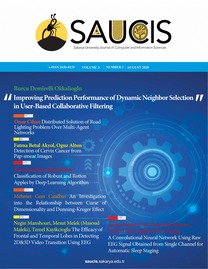Vücut Alan Ağları için Enerji Hasadı Ünitesi Tasarımı
Energy Harvesting Unit Design for Body Area Networks
___
[1] A. Chen, “Thermal energy harvesting with thermoelectrics for self-powered sensors: with applications to ımplantable medical devices, body sensor networks and aging in place,” Doktora Tezi, UC Berkeley, 2011.[2] E. W. Ford, N. Menachemi, and M. T. Phillips, “Predicting the adoption of electronic health records by physicians: when will health care be paperless?,” Journal of the American Medical Informatics Association, cilt. 13, no. 1, pp. 106–112, 2006.
[3] M. A. Wood and K. A. Ellenbogen, “Cardiac pacemakers from the patient's perspective,” Circulation, cilt. 105, pp. 2136–2138, 2002.
[4] A. Liberale, E. Dallago and A. L. Barnabei, “Energy harvesting system for wireless body sensor nodes,” 2014 IEEE Biomedical Circuits and Systems Conference (BioCAS) Proceedings, Lausanne, pp. 416-419, 2014.
[5] Z. Liu, Z. Zhong and Y. Guo, “High-efficiency triple-band ambient RF energy harvesting for wireless body sensor network,” 2014 IEEE MTT-S International Microwave Workshop Series on RF and Wireless Technologies for Biomedical and Healthcare Applications (IMWS-Bio2014), pp. 1-3, London, 2014.
[6] R. K. Tallos, Z. Wang and J. L. Volakis, “Wi-Fi energy harvesting system using body-worn antennas,” 2014 IEEE Antennas and Propagation Society International Symposium (APSURSI), Memphis, TN, pp. 1405-1406, 2014.
[7] R. Lockhart, P. Janphuang, D. Briand and N. F. de Rooij, “A wearable system of micromachined piezoelectric cantilevers coupled to a rotational oscillating mass for on-body energy harvesting,” 2014 IEEE 27th International Conference on Micro Electro Mechanical Systems (MEMS), San Francisco, CA, pp. 370-373, 2014.
[8] G. Wu and X. Yu, “System design on thermoelectic energy harvesting from body heat,” 2013 39th Annual Northeast Bioengineering Conference, Syracuse, NY, 157-158, 2013.
[9] G. De Pasquale and A. Somà, “Energy harvesting from human motion with piezo fibers for the body monitoring by MEMS sensors,” 2013 Symposium on Design, Test, Integration and Packaging of MEMS/MOEMS (DTIP), Barcelona, pp.1-6, 2013.
[10] R. Kappel, W. Pachler, M. Auer, W. Pribyl, G. Hofer and G. Holweg, “Using thermoelectric energy harvesting to power a self-sustaining temperature sensor in body area networks,” 2013 IEEE International Conference on Industrial Technology (ICIT), Cape Town, pp. 787-792, 2013.
[11] N. Ben Amor, O. Kanoun, A. Lay-Ekuakille, G. Specchia, G. Vendramin and A. Trotta, “Energy harvesting from human body for biomedical autonomous systems,” SENSORS, 2008 IEEE, Lecce, pp. 678-680, 2008.
[12] S. Kosunalp and A. Cihan, “Harvesting solar energy for limited-energy problem in wireless sensor networks,” 2017 25th Signal Processing and Communications Applications Conference (SIU), Antalya, pp. 1-4, 2017.
[13] M. Saida, G. Zaibi, M. Samet and A. Kachouri, “Improvement of energy harvested from the heat of the human body,” 2016 17th International Conference on Sciences and Techniques of Automatic Control and Computer Engineering (STA), Sousse, pp. 132-137, 2016.
[14] A. Ghosh, Meenakshi, S. Khalid and V. P. Harigovindan, “Performance analysis of wireless body area network with thermal energy harvesting,” 2015 Global Conference on Communication Technologies (GCCT), Thuckalay, pp. 916-920, 2015.
[15] A. Proto, D. Bibbo, M. Cerny, D. Vala, V. Kasik, L. Peter, and M. Penhaker, “Thermal energy harvesting on the bodily surfaces of arms and legs through a wearable thermo-electric generator,” Sensors, 18(6), 1927, 2018.
[16] P. Woias, “Thermoelectric Energy Harvesting from small and variable Temperature Gradients,” Tagungsband, pp. 83-88, 2015.
[17] “MySignals Web Sitesi [Online]. Available: http://www.my-signals.com/. [Accessed Jan 10, 2019].
- ISSN: 2636-8129
- Yayın Aralığı: Yılda 3 Sayı
- Başlangıç: 2018
Makine Öğrenmesi ile Ürün Kategorisi Sınıflandırma
Vücut Alan Ağları için Enerji Hasadı Ünitesi Tasarımı
ALİ ÇALHAN, Köksal GÜNDOĞDU, Murtaza CİCİOĞLU, MUHAMMED ENES BAYRAKDAR
Computer-Aided Detection of Lung Nodules in Chest X-Rays using Deep Convolutional Neural Networks
Derin Öğrenme Algoritmalarını Kullanarak Görüntüden Cinsiyet Tahmini
Gül GÜNDÜZ, İsmail Hakkı CEDİMOĞLU
Deep Learning Performance on Medical Image, Data and Signals
